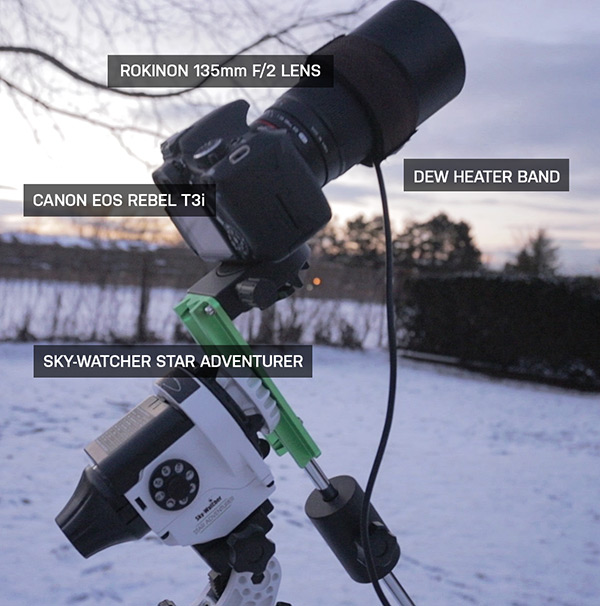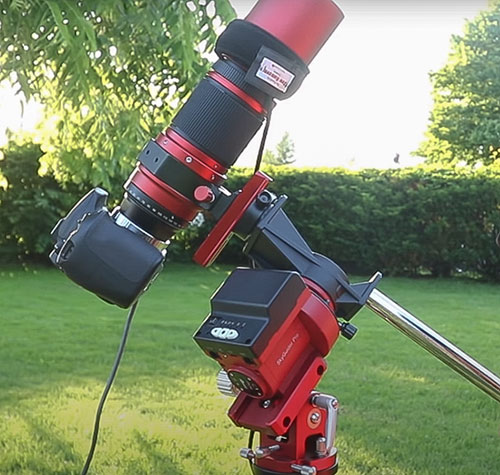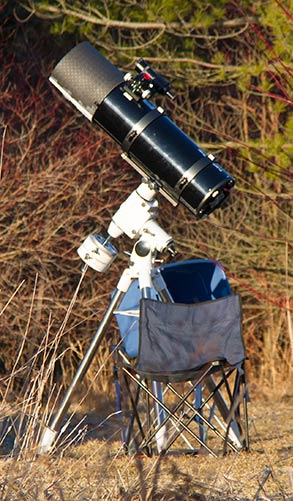Dew Heaters for Astrophotography
Dew heaters are warming devices that are wrapped around your telescope or lens to prevent condensation and keep your optics free of moisture throughout the night.
They are an essential tool for astrophotographers looking to avoid the frustration of interrupted sessions caused by fogged-up equipment. They can make the difference between capturing hours of valuable exposures on a target or leaving empty-handed.
The good news is that there are a number of solutions available for keeping your telescope or lens objective moisture-free. The method you choose will depend heavily on the type of telescope you are using.
In this post, we’ll cover types of dew heaters and dew heater controllers, setting up your dew heater and alternative options.
Moisture and frost can end your observing or astrophotography session early.
Why Dew Formation is a Problem
When the surface of your telescope objective or camera lens drops below the ambient temperature of the air outside, moisture begins to condense. On a night with high levels of moisture in the air, dew forms even more aggressively.
A ‘dewed-up’ telescope objective lens no longer captures clear images of your deep-sky target. Instead captures a washed-out, featureless image that resembles a flat frame.
To be a little more technical, the heat from the warmer telescope transfers to the colder outside temperature via radiation. When the telescope radiates its heat to the sky, it quickly cools down and drops below the dew point temperature.
This chain of events causes condensation to form on your telescope or camera lens (as well as eyepieces, mirrors, etc.).
Types of Dew Heaters
There are many options available for backyard astrophotographers battling dew.
Dew Heater Brands/Straps
Dew heater bands are the most common type of dew prevention. They are flexible, heat-emitting straps that wrap around the telescope’s optical tube or camera lens, preventing condensation by gently warming the surface.
You’ll need a dew heater band for each telescope, guide camera, or camera lens you want to keep dry. You will need to power each dew heater via a power source or a controller.
RCA (left) vs USB (right) Dew Heater Bands
I have used many dew heater bands over the years, from simple USB-powered devices to the traditional ‘RCA-type’ bands that require a controller to run. I personally prefer to use USB-powered dew heater bands whenever possible. They can easily be plugged into your power bar or portable power station with powered USB ports.
Make sure to select a dew heater band with enough length to reach the objective of your telescope from the USB port.
Here are few options in the Dew Heater game:
Dew-Not dew heater strips are power-efficient using an efficient design and a velcro strip on one side for attachment and a standard six foot cord.
Kendrick Astro Instruments is a Canadian company and they produce high quality dew heaters. I used this particular brand for many years. The Firefly Heaters offered by Kendrick are designed to save power and operate from 12 Volts DC.
Integrated Dew Heaters
Some high-end telescopes and cameras can have built-in dew heaters, which are controlled via onboard systems to maintain optimal temperatures.
Dedicated astronomy cameras, like the ZWO ASI line, have an anti-dew option that you can turn on to help control dew.
ZWO ASI2600MC Air Camera with built-in Anti-dew Function
Dew Heater Controllers
Dew heater controllers are devices that regulate the power supplied to dew heater bands, ensuring optimal heat distribution to prevent condensation without overheating your equipment.
If you are using RCA compatible dew heater bands, you will need to have one of these devices to control power output to each dew heater band.
They can range from simple manual models to advanced controllers with automated sensors that adjust heat output based on real-time temperature and humidity data.
Here are a few popular examples of dew heater controllers:
Pegasus Astro Pocket Powerbox
The Pegasus Pocket Powerbox is a compact power management hub designed to streamline astrophotography setups by centralizing power and USB connectivity.
First generation Pegasus PowerBox
It features four 12V DC power outputs, two adjustable dew heater ports, and a four-port USB 3.2 hub, all controlled from a single unit. With the ability to regulate dew heaters based on real-time data, it ensures clear optics during imaging sessions.
Second generation Pegasus Pocket Power Box
It also offers remote control and monitoring capabilities through its software, allowing users to track power usage, voltage, and environmental conditions. Ideal for reducing cable clutter and managing power efficiently, the Pocket Powerbox is a reliable solution for optimizing your gear.
Thousand Oaks Digital Dew Heater Controller
The Thousand Oaks Dew heater controller is known to be a reliable, user-friendly device that prevents dew formation on telescope optics by regulating heat output.
It features 4 independent channels, each capable of controlling a dew heater strip with adjustable power settings to match outdoor conditions. The digital interface makes it easy to monitor and adjust heat levels, ensuring that optics stay clear without overheating.
With the ability to connect multiple dew heater straps, it provides a practical solution for managing dew protection during long observing or imaging sessions.
DewBuster Controller
This controller has 10 RCA jacks offering different levels of temperature output. I used this particular model for many years, and used the medium power outputs when heating the bands on my imaging and guide scope.
DewBuster brand Dew Heater Controller
The medium power jacks offer a steady output of heat to the bands that effectively keep dew from my optics all night long. The dew heater controller includes a cigarette lighter plug power cord that I plug into my battery pack or adapter unit.
Below, is a diagram of how the DewBuster controller sends heat to various dew heater straps. As mentioned earlier, I stick with the medium power outputs when controlling the bands on my refractor telescopes.
Diagram from the DewBuster website
Choosing a Dew Heater
Choosing the right dew heater band for your telescope or lens is key to keeping your astrophotography gear performing at its best.
Aperture Size
Start by figuring out the size of your telescope’s optical tube or the diameter of your camera lens. Dew heater bands come in different lengths to fit various sizes, so you’ll want to pick one that matches the circumference of your optics.
For instance, a small refractor will need a shorter band, while something like a larger Schmidt-Cassegrain or Newtonian reflector will need a longer one. Most manufacturers list the telescope size range their bands are designed for, so that part is pretty straightforward.
Dew Heater Brands wrapped around main telescope and guide scope.
Larger telescopes, such as the Dobsonian design, may benefit from a primary mirror heater. There are also secondary mirror heaters prevent dew from ending a night of observing. Newtonian reflectors often use fans to prevent moisture build-up. Read more on this subject by Gary Seronik.
Compatibility
Next, check for compatibility. While most dew heater bands can work with a variety of telescopes and lenses, it’s always good to make sure the one you’re considering is a good fit for your specific gear.
Some brands offer bands tailored for particular telescope types, like those made for Schmidt-Cassegrain scopes, which fit around the large corrector plate. If you’re using a camera lens for wide-field astrophotography, there are smaller bands designed to fit snugly around the lens without interfering with focus rings or lens hoods.
Dew heater band around the Redcat 51
Power Consumption
Power consumption is another important factor, especially if you’re using a portable setup that runs on batteries. Larger dew heater bands use more power to keep your optics warm, so it’s a good idea to use a dew heater controller.
This lets you fine-tune the heat output depending on the weather conditions, so you’re not running the heater at full power all night. Not only does this save battery life, but it also prevents overheating, which can affect the clarity of your optics.
Portable Power Station for plugging in dew heaters
In the end, choosing the right dew heater band is about balancing effective dew prevention with smart power usage. By matching the size of your optics, ensuring compatibility, and managing power efficiently, you’ll keep your gear free of dew and enjoy longer, uninterrupted imaging sessions.
Setting Up a Dew Heater
Here are my steps for setting up for a night of astrophotography:
Main Telescope
I start by wrapping a dew heater band my primary imaging telescope. It should be wrapped around the base of the objective lens, at the bottom of the dew shield (if applicable). The same applies when using a dew heater strap with a small camera lens.
Guide Scope
Make sure you wrap a dew heater band around your guide scope, as moisture can develop on that smaller telescope as well, and affect autoguiding performance.
Turn Dew Heaters On
Depending on your type of dew heater band, it can be powered via a dew heater controller or plugged into a USB powered by AC power. Plug in your dew heaters and turn them on.
Cable Management
It is important to implement cable management so your dew heater band cables will not catch on anything as your telescope tracks the motion of the night sky throughout the night.
Best Practices for Dew Heaters
Dew heater bands are essential in environments with high humidity, rapidly cooling temperatures, or clear, calm nights where condensation is more likely to form on your telescope’s optics.
If you’re observing or imaging in damp areas or during cool nights when the temperature drops, dew is almost inevitable, making dew heaters a must. They’re especially useful when the dew point is close to the air temperature.
However, if you’re in a desert-like climate with low humidity, or during windy nights that prevent moisture from settling on surfaces, you might not need a dew heater band at all.
It’s always a good idea to check the forecast for humidity and temperature conditions before deciding if a heater is necessary. Or if you’re like us – they are just always a part of your packing list when we travel.
Alternatives
There are a few alternatives to using dew heaters, which could be helpful depending on your set up. Though, these are not permanent options to remove dew for long periods of time.
Dew Shields
Dew Shields are an alternative to using a dew heater. They can effectively delay the process of dew forming on your optics, but it won’t stop it completely. It reduces the angular amount of sky seen by the telescope objective and can keep moisture at bay for an extended period of time.
As an added benefit, a dew shield can increase the contrast in your images by acting as a light baffle. A dew shield blocks stray light from entering the telescope lens, and can also protect it from any dust and dirt in that is stirred up around the telescope.
My homemade dew shield (camping mat) on a Newtonian Reflector
Most of the refractor telescopes I have used include a built-in, retractable dew shield, such as the William Optics Z61. I have also constructed a homemade dew shield for my Newtonian reflector using a soft foam material similar to a camping mat.
Hair Dryer
If you don’t have a dew heater system yet, you may be able to get by using a household hair dryer. I have used this method in the past when I was desperate to clear the moisture from my optics. This isn’t an ideal option, as dust and debris can be blown from the hairdryer and stick to the moisture as it dries.
But beware, hair dryers are also notorious for using dangerously high amounts of power that can drain your battery in a hurry. I would only suggest using this option if you are imaging from home and connected to household AC power. A good blow using heat will dry your telescope or camera lens in about a minute or two.
You can also leave a fan running in the direction of your equipment to keep the air moving, and condensation from settling on your gear. This method has many of the same drawbacks as the hair dryer technique in terms of power consumption and efficiency.
Conclusion
I hope that you can see the value of using dew heaters for astrophotography. This simple step can ensure that your telescope is able to capture clear images all night long.
No matter which system you decide to use, just remember to turn it on and avoid the heartbreaking realization that you have squandered hours of imaging time under clear skies!
I use dew heater bands on all of my astrophotography configurations from my primary imaging setup to my portable deep sky kit.
If battery power consumption is an issue, be sure to have a reliable source of power for mobile imaging sessions established before adding dew heaters.
Trevor Jones is a deep-sky astrophotographer and a valued member of the RASC. His passion is inspiring others to start their astrophotography journey on his YouTube Channel so they can appreciate the night sky as much as he does. His images have been featured in astronomy books & online publications, including the NASA Astronomy Picture of the Day (APOD).

















